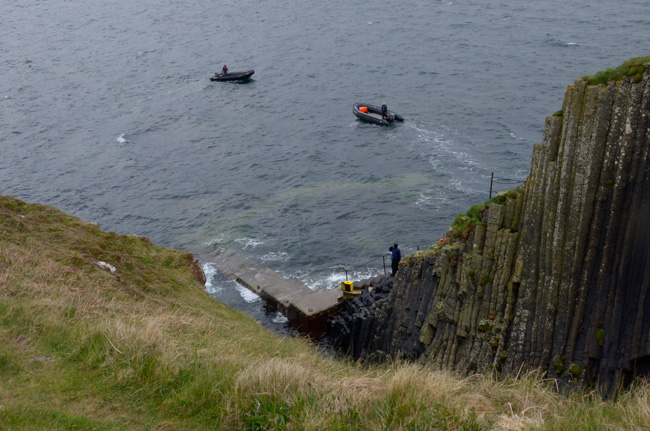There is more to Staffa than Fingal's Cave or the Puffin nests.
Prior to landing we enjoyed Zodiac cruises around the island. I decided to forgo the hike to Fingal's Cave, having done it before. At the puffin burrows I despaired (again) of getting any darling pictures. I then explored the rest of the island -- beautiful in its austerity.
Fingal's Cave march is one of the tunes that I play. It can also be played as a strathspey.

Our crew had an ulterior motive by starting our visit with a circumnavigation cruise: metering the number of passengers deposited at the very restricted landing site. My Zodiac was piloted by one of the more enthusiastic drivers. He backed into Fingal's Cage and gunned the engines to shoot us out over the waves crashing at the entrance. After doing it once, he asked if we wanted to do it again. You bet! Gotta love those waterproofs.
Later we threaded our way through puffins hanging out in the water below their burrows on the high cliffs. When it was our turn, we unloaded and clambered up the steep stairs to the surface of the island.
Staffa is made up of columns similar to the Giant's Causeway.

This is the best shot I got of a puffin. It only took about 30 minutes of waiting. Now if I can just convince my camera's autofocus to, er, focus!

The island was rather crowded. There were a number of visitors who were not with our group. It was a Friday and it isn't always possible to land on Staffa, so I expect that many had been awaiting a favorable day to visit.

The island is not large and it is easy to walk around the entire space. Depressions where water collects are prime places for reeds to grow. Wading into them is treacherous. I was glad that I had kept on my waterproof "wet landing" boots.

The entire island is formed of the basalt columns.

At one point I got too close to a great skua nest to suit the parents. Even though I beat a hasty retreat, the birds were dive-bombing me. As they are quite large it was intimidating. I felt pretty brave standing my ground long enough to get some pictures.
Later in the Faroe Islands we saw skuas attacking a lone hiker. He was less brave (or more sensible) and covered his head as he lay down in the grass.

The island hasn't been inhabited since the early 19th century. The only sign of habitation I saw was the ruins of an isolated croft.
Click your "back" button to return to the previous page or click for our picture album.